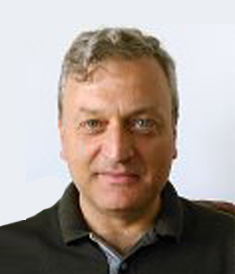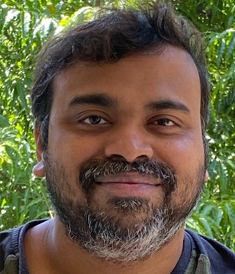CYBER PHYSICAL SYSTEM
Talk Title, Abstract & Bio of Speakers

Dr. Arundhati Misra
Presentation Schedule: 2.15 PM - 2.50 PM
Talk Title: Microwave Remote Sensing techniques and applications
Abstract: The talk will discuss the advantages and challenges of terrestrial, airborne, and near and far spaceborne microwave remote sensing systems for a wide variety of applications such as disaster management, climate change, planetary science, and oceanography.
Bio: She received her BE in Electronics and Tele Communication Engineering and ME in Computer Science Engineering in 1984 and 1986 respectively from Jadavpur University, Calcutta. She completed her PhD, in Computer Science Engineering from Nirma University, Ahmedabad as an external candidate, in 2017.
She has been involved in the design and development of SAR processing algorithms for various SAR missions including Seasat, ERS-1 and ISRO's first Airborne SAR sensor and RISAT-1. She contributed extensively to the design and development of a parallel processor based SAR processor, on PARAM (India's first indigenous supercomputer), of CDAC, India. She was a member of the team to receive the '100 MFLOPS PARAM Award'. She served as Project Manager for ISRO's Multifrequency Scanning Microwave Radiometer and also contributed as Deputy Project Director, for Data Products for the Joint ISRO-CNES, 'Meghatropiques' project. She had contributed to the simulation studies and configuration design of ISRO's proposed millimeter wave sounders TSU & HSU. She was deputed as a Guest Scientist at DLR, Oberpfaffenhofen, Germany, where she developed the DInSAR processing algorithm for the German ESAR sensor.
Currently she is the Group Director of Advanced Microwave and Hyperspectral Techniques Development Group, in SAC. Her research interests include SAR, radiometer, scatterometer simulation and processing, and advanced algorithm development related to microwave sensors, InSAR, PolSAR, Hyperspectral data analysis etc. She is also a member of the CEOS_WGCV since 2016.
She has several research publications in international and national journals and technical reports of SAC.

Prof. Andrew Lord
Presentation Schedule: 2.50 PM - 3.25 PM
Talk Title: How will optical networks be different in the next ten years?
Abstract: This talk will look at the current state of communications networks. It will go on to assess the pressures, current and future, on these networks. It will then address the likely changes and evolution of current networks to cope with future traffic growth, electrical power consumption and spiralling costs. The talk will be wide-ranging, looking at limits to Moore’s and Shannon’s laws as well as addressing recent developments in quantum communications.
Bio: Andrew joined BT in 1985 after a BA in Physics from Oxford University. He has helped design a wide range of optical network systems and technologies, including long haul subsea and terrestrial DWDM networks. He has been responsible for optical fibre and systems specifications. He currently leads BT’s optical research including optical access, high speed transmission and quantum communications. He has recently initiated BT’s quantum research, with applications in areas such as secure communications, timing and sensing. He regularly speaks at conferences, sits on several organising committees, including ECOC and was Technical Program Chair for OFC 2015 and General Chair for OFC 2017. He will be TPC co-chair of ECOC 2023. He is Editor-in-Chief of the Journal of Optical Communications and Networking, He is Visiting Professor at Essex University, Senior Member of the IEEE and a BT Distinguished Engineer.

Dr. Roberto Sabella
Presentation Schedule: 3.25 PM - 4.00 PM
Talk Title: Cyber-Physical System for Industry 4.0

Giulio Bottari
Presentation Schedule: 3.25 PM - 4.00 PM
Talk Title: Cyber-Physical System for Industry 4.0
Abstract: A cyber-physical system is an integration of systems with varying natures whose main purpose is to control a physical process and, through feedback, adapt itself to new conditions in real time. They're created at the intersection of physical processes, networking, and computation.
The essential component of cyber-physical systems is the presence of interconnected objects which, through sensors, actuators and a network connection, generate and acquire data of various kinds. With the help of integrated sensors, cyber-physical systems can autonomously determine their current operating status within the environment in which it is located, and the distances between objects. Actuators serve to carry out planned actions or to implement corrective decisions, for example, optimizing a process or solving a problem. Decisions are made by AI which evaluates information from its own internal sensors and information shared by other cyber-physical systems.
Communication is vital in cyber-physical systems, as they allow different objects to exchange information with each other and with humans, at any time and in any conditions. Communication challenges are the performance indicators like latency, jitter, reliability, security and throughput. They largely impact the dynamic interactions between CPS sub-systems. In addition, factors like device locations, propagation conditions, and traffic load are changing over time. To cope with these tight requirements, cellular networks, 5G in particular, emerges and the ideal companions for the CPS evolution providing deterministic and guaranteed performances at scale.
In the future, CPSs will be present in all industry sectors. In this keynote speech, we explore the case of Industry 4.0 sector that many analysts consider highly important is the CPS scenario. It includes both smart manufacturing and logistics. In all cases, these complex systems are required to be self-configuring, self-adjusting, and self-optimizing; leading to greater agility, flexibility, and cost effectiveness.
In the Industry 4.0 scenario, we present the experimental deployments we made with key partners that helped us to establish the requirements on 5G needed to run CPSs in realistic and challenging environments.
Bio: Roberto Sabella (Senior Member, IEEE) received the Degree in electronic engineering in 1987. After one year of experience on radar systems he joined Ericsson when he was HW Designer, System Engineer, Researcher and, starting from 1997, manager of different departments, spanning from system engineering, technology and innovation and Research Manager. He is currently the Head of the Optical Systems Department of Ericsson Research, based in Pisa, Italy, and Montreal, Canada, which carry out research on transport network architecture and systems for radio networks, high-capacity optical transmission and switching systems for mobile network evolution towards the 6th generation, integrated photonic technologies, photonic interconnects and processing subsystems and modules for future radio systems and HW platforms. During his career, he has authored or coauthored more than 150 papers on peer-reviewed journals and international conferences, two books on optical communications, and holds more than 30 patents. He was an Adjunct Professor of telecom systems design with the University of Rome La Sapienza and lecturers in several European universities. He has guest edited many special issues in several IEEE journals and magazines. In addition, he organized international conferences and workshops on different topics and be one of the Technical Program Committee Co-Chair of ECOC 2018 conference in Roma.
Bio: Giulio Bottari is a master researcher in at Ericsson Research in Pisa, Italy. His research interests include transport for radio, optical networks, and ICT applications for industries. He has been a reference person of Ericsson Research for the “5G for Italy” program which developed the first 5G manufacturing area in Italy, operating in the Comau (FCA) plant in Turin in June 2018. Giulio has been the Innovation Manager of the H2020 5G Transformer project and he is also a reference person for the H2020 5Grwoth European project which experiments 5G-based use cases for cyber-physical systems scenarios in smart manufacturing. Giulio is the author of 80 patents and several articles in IEEE/OSA publications. He holds a Master’s Degree in Telecommunication Engineering from the University of Pisa, Italy.

Dr. Subhra Kanti Das
Presentation Schedule: 4.00 PM - 4.35 PM
Talk Title: Open Hardware - The Road Ahead
Abstract: In this talk, I will try to address the fundamental aspects of Open hardware consortium in terms of needs, objectives, eco-system and licenses. Following the overview, I will tend to cover areas of interest to Thales, including micro-architecture optimization, vector extension and software eco-system developments. Towards the end of my presentation, I will briefly introduce the topics of collaborative research with IIIT Delhi.
Bio: Subhra is currently the Head of RISC-V developments at Research and Technology Group in the Engineering Competence Center (ECC) of Thales India Pvt Limited at Bangalore. In his current role, he is driving the eco-system in India for RISC-V research and technology enhancement as part of Thales global strategy towards open hardware. He is steering multiple collaborations with academic institutions, like IIT Madras and IIIT Delhi, along with nodal Govt R&D organisations, DRDO and MeitY, in India and with OpenHW Consortium, Thales Research and Technology centers in France, Singapore and Canada, in order to demonstrate and develop core potential of RISC-V as a disruptive technology in the world of computing infrastructure. His current area of work and interests are Safety NoC for multi-core systems, XAI and DSP micro-architectures.
